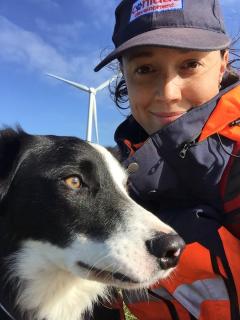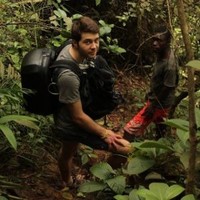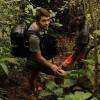Environmental DNA, or eDNA, is a molecular sampling technology that collects information about organisms using DNA shed by them into their environment. While eDNA holds exciting potential to become an efficient, low-cost, non-invasive ecological monitoring method, a lack of standardization of approaches and purpose-built sampling equipment make it hard to compare results and determine its actual effectiveness across studies. Detection success and accuracy also vary greatly among species and environments, making standardization a challenge.
However, as eDNA moves toward becoming an industry standard method for species detection and management, the equipment is beginning to transition from largely do-it-yourself experimental contraptions to professionally engineered tools. For example, Smith-Root Inc. recently developed the first-ever purpose-built eDNA sampling system, which they call ANDe™. We’re also seeing an expansion of eDNA applications from mainly marine to freshwater and even terrestrial environments, although the latter still requires substantial growth.
As this nascent field develops, it is critical for the conservation tech community to explore and identify how eDNA applies to management needs, and to ensure that continued development meets those needs. Beyond indicating species presence, research so far suggests that eDNA can contribute to conservation by deepening understanding of population dynamics, resource usage, disease presence, invasion pathways of non-native species, and population genetics, to name a few. This indicates that it could be a critical tool for managing imperiled and invasive species.
If you're new to eDNA and genomics, check out our Tech Tutors episode "How Do I Use Portable Genomics in the Field?" featuring Ineke Knot. You'll also find a bank of resources on that page, including a handy glossary of terms in our collaborative notes document!
Does your work involve eDNA and genomics, or are you curious about incorporating this type of technology into your field or lab work? Start a discussion in our group forum!
Header Image: Benjamin Barca
- @heiabb02
- | she/her
Early Career Wild Felid conservationist with BS in Biology & Zoology
- 0 Resources
- 0 Discussions
- 6 Groups
- @amklovrza
- | she / her
Hello! My name is Anabelle Marques Klovrza and I am a Ph.D. student at Dawson's lab. I am studying community assembly of island-like environments, and in trying to connect it with the vulnerability and fragility of the ecosystem.
- 0 Resources
- 0 Discussions
- 8 Groups
- @hyodopenguin
- | she/her
I am currently a rising junior at UC Berkeley studying data science. I hope to apply data with biodiversity, especially by utilizing camera traps for species classification. People in conservation tech are truly living my dream careers, and I can't wait to get even more inspired!

- 0 Resources
- 5 Discussions
- 23 Groups
I'm a researcher in aquatic sciences, studying connections between fish biology and endocrine systems that govern growth and reproduction, contributing to fisheries management, conservation efforts and aquaculture innovations.
- 0 Resources
- 0 Discussions
- 5 Groups
- 0 Resources
- 4 Discussions
- 7 Groups
- 0 Resources
- 0 Discussions
- 9 Groups
- @Mathilde
- | she/her
Natural Solutions
Engineer, I work for a web development company on web application projects for biodiversity conservation. I'm especially interested by camera traps, teledetection and DeepLearning subjects.
- 0 Resources
- 0 Discussions
- 11 Groups
Wildlife Drones
Wildlife Drones has developed the world’s most innovative radio animal-tracking system using drones so you can track your radio-tagged animals like never before.


- 18 Resources
- 8 Discussions
- 32 Groups
- @affiliatepurna
- | general email id
Purna Man Shrestha is a program coordinator of mountain spirit, Nepal. He has 6 years of working experience in human wildlife interaction focusing on wildcats, and conflicts. He has a good knowledge on wildlife survey techniques, field survey, stakeholder engagement
- 0 Resources
- 0 Discussions
- 11 Groups
PhD Candidate in autonomous marine biodiversity modelling

- 0 Resources
- 11 Discussions
- 8 Groups
FruitPunch AI
CTO and Founder of FruitPunch AI




- 0 Resources
- 4 Discussions
- 11 Groups
- 0 Resources
- 0 Discussions
- 17 Groups
In this news article by Rutherford Discovery Fellow Emma Carroll, we learn about how genomics and satellite data are helping researchers gain a new understanding of southern right whale population recovery, migration...
5 November 2020
Funding
The 2020 Hackaday Prize competition has begun! This year, Conservation X Labs has partnered with the Hackaday Prizes as one of four nonprofits seeking tech-based solutions to urgent challenges. Conservation X Labs'...
26 May 2020
The WILDLABS TECH HUB is supporting technology solutions tackling the illegal wildlife trade, in collaboration with the Foreign & Commonwealth Office, Digital Catapult, Satellite Applications Catapult, Amazon Web...
4 June 2019
In February, we released an open call for the WILDLABS TECH HUB, offering 3 months of support for solutions using technolgy to tackle the illegal wildlife trade. We were overwhelmed by an incredible 37 submissions,...
13 May 2019
Article
A new research project is looking to investigate whether technology combined with the ancient skills and knowledge of Namibian trackers can help save cheetahs from extinction. Called FIT Cheetahs, the research project...
4 December 2017
What makes a good detection dog handler? Is it something that can be taught and learnt over time, or is it something more intuitive? Do some people just have what it takes, and other people don’t? At the start of 2017...
3 November 2017
Welcome to an installment of a new series from the Wildlife Crime Tech Challenge in which we will be sharing updates from their 16 Prize Winners who are working to combat wildlife crime around the globe. Slow lorises...
23 June 2017
Are you ready for this year's #Tech4Wildlife Photo Challenge? In anticipation, we're counting down our ten favourite entries from last year. Do you think you can top these?
1 March 2017
The Conservation Leadership Programme (CLP) is a training and capacity building programme that targets individuals from developing countries who are early in their conservation career and demonstrate leadership...
21 November 2016
In 2014, when Mariah Pfleger volunteered to sift through water samples from Alabama’s Mobile River Basin, she wasn’t expecting to solve one of biology’s most frustrating missing fishes cases.
18 November 2016
Technology by itself will not save pangolins or elephants, but it can help make major progress.
14 November 2016
Do you work on conserving Neotropical migratory birds? Do you need funding? Why not apply for a grant from the U.S. Fish and Wildlife Service through the Neotropical Migratory Bird Conservation Act's grant program? The...
8 November 2016
November 2023
event
October 2023
6 Products
Recently updated products
| Description | Activity | Replies | Groups | Updated |
|---|---|---|---|---|
| Hi @skirchgeorg , thanks for the additional info. We discuss again about this with my colleague and we were still hesitating with the drone, as it will still make some noise that... |
|
Drones, eDNA & Genomics | 1 month 3 weeks ago | |
| Hi Nabil,What medium do you want to sample for your eDNA (soil/air/water)? If its soil then you can simply collect a sample in a bag and freeze.This is a nice soil collection... |
|
eDNA & Genomics | 3 months ago | |
| Hi all, I am trying to find simple pre-assembled eDNA sampling kits like these below but for sale in North America. Is that... |
|
eDNA & Genomics | 3 months 1 week ago | |
| Hi Simon,We (Reneco International Wildlife Consultants) have an ongoing collaboration with a local University (Abu Dhabi, UAE) for developing AI tools (cameratrap/drone... |
|
Acoustics, AI for Conservation, Animal Movement, Camera Traps, Citizen Science, Connectivity, Drones, Early Career, eDNA & Genomics, Marine Conservation, Protected Area Management Tools, Sensors | 4 months 1 week ago | |
| Hi Muhammed,If you want any help with ONT please contact me |
|
eDNA & Genomics | 4 months 2 weeks ago | |
| Hi Phil, Thanks for sharing - this is really interesting work! Seems like a cool integration of ground-based (or ocean-based) data and satellite data, with a community... |
|
Geospatial, Acoustics, Camera Traps, eDNA & Genomics | 7 months 4 weeks ago | |
| Thank you so much! Now everything is in the hands of amazing organizations and companies! But the first results of the Disaster Management cohort are bringing a very optimistic... |
|
AI for Conservation, Climate Change, Early Career, East Africa Community, eDNA & Genomics, Emerging Tech, Ending Wildlife Trafficking Online, Human-Wildlife Conflict, Open Source Solutions | 9 months 3 weeks ago | |
| Hello everyone, I'm interested in gathering insights on how the behavior of different species impacts the development and efficacy of... |
|
Animal Movement, Acoustics, Camera Traps, eDNA & Genomics, Emerging Tech, Marine Conservation | 1 year 2 months ago | |
| Hi everyone. I'm still confused about this. Is it feasible to employ environmental DNA (eDNA) for the detection of two distinct communities... |
|
eDNA & Genomics | 1 year 2 months ago | |
| Thanks Aude, very useful. Will reach out to them! |
|
Early Career, Acoustics, eDNA & Genomics, Marine Conservation, Protected Area Management Tools | 1 year 4 months ago | |
| Carly, that would be great! Thanks! I work with soundscapes and love the work of Rainforest Connection! I'll send you an email (@CUNY) to coordinate! |
|
Acoustics, AI for Conservation, Conservation Tech Training and Education, Drones, eDNA & Genomics, Emerging Tech, Geospatial | 1 year 11 months ago | |
| Thanks so much!! |
|
Acoustics, AI for Conservation, Animal Movement, Camera Traps, Community Base, Data management and processing tools, Drones, eDNA & Genomics, Emerging Tech, Open Source Solutions, Geospatial, Software Development | 2 years 7 months ago |

































